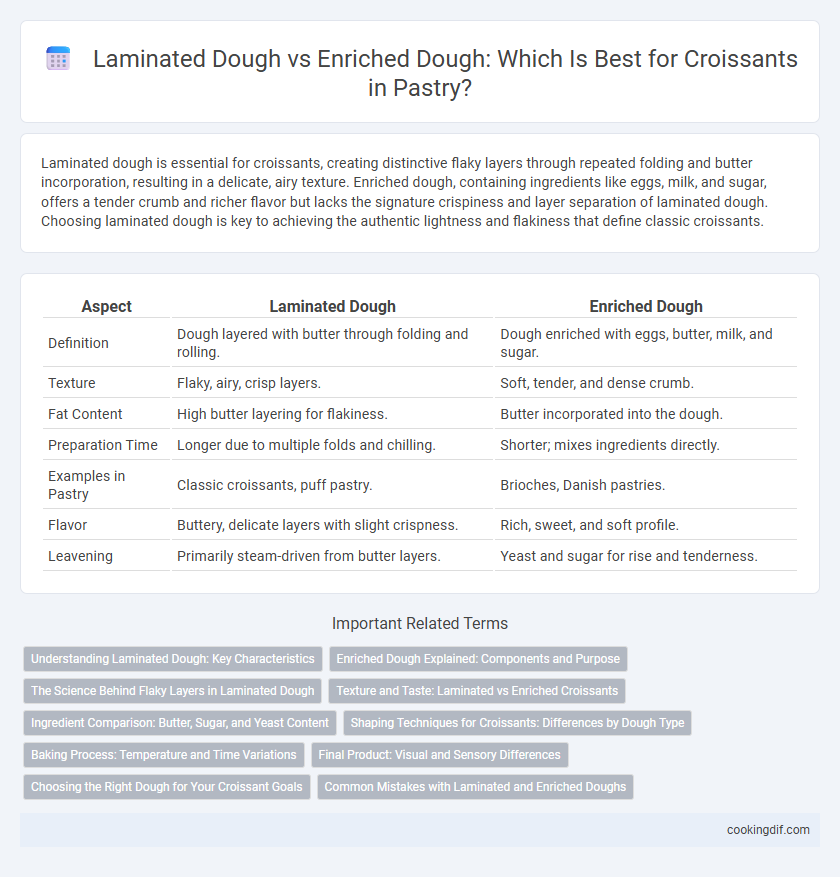Laminated dough is essential for croissants, creating distinctive flaky layers through repeated folding and butter incorporation, resulting in a delicate, airy texture. Enriched dough, containing ingredients like eggs, milk, and sugar, offers a tender crumb and richer flavor but lacks the signature crispiness and layer separation of laminated dough. Choosing laminated dough is key to achieving the authentic lightness and flakiness that define classic croissants.
Table of Comparison
| Aspect | Laminated Dough | Enriched Dough |
|---|---|---|
| Definition | Dough layered with butter through folding and rolling. | Dough enriched with eggs, butter, milk, and sugar. |
| Texture | Flaky, airy, crisp layers. | Soft, tender, and dense crumb. |
| Fat Content | High butter layering for flakiness. | Butter incorporated into the dough. |
| Preparation Time | Longer due to multiple folds and chilling. | Shorter; mixes ingredients directly. |
| Examples in Pastry | Classic croissants, puff pastry. | Brioches, Danish pastries. |
| Flavor | Buttery, delicate layers with slight crispness. | Rich, sweet, and soft profile. |
| Leavening | Primarily steam-driven from butter layers. | Yeast and sugar for rise and tenderness. |
Understanding Laminated Dough: Key Characteristics
Laminated dough for croissants features multiple layers of butter folded within the dough, creating a flaky and airy texture essential to traditional French pastries. The lamination process involves precise temperature control and repeated rolling to ensure even butter distribution and distinct layers. This technique contrasts with enriched dough, which relies on higher butter and sugar content for richness but lacks the characteristic flakiness of laminated dough.
Enriched Dough Explained: Components and Purpose
Enriched dough for croissants contains higher fat content, primarily from butter, along with sugar, eggs, and milk, which contribute to its rich flavor and soft texture. The inclusion of these components enhances moisture retention and tenderizes the crumb, resulting in a delicate, tender pastry. This dough is designed to create croissants with a tender bite and slightly sweet taste, distinguishing it from laminated dough's emphasis on flaky layers.
The Science Behind Flaky Layers in Laminated Dough
The science behind flaky layers in laminated dough relies on the precise layering of butter and dough, which creates steam during baking that separates and puffs each thin layer. Laminated dough undergoes multiple folds and turns, producing hundreds of delicate, crisp layers essential for classic croissant texture. In contrast, enriched dough incorporates fats and sugars more uniformly, resulting in a softer, tender crumb rather than the distinct flakiness seen in laminated pastries.
Texture and Taste: Laminated vs Enriched Croissants
Laminated dough croissants feature multiple layers of butter and dough, creating a flaky, airy texture with a delicate crispness and a subtle, buttery taste. Enriched dough croissants incorporate ingredients like eggs, sugar, and milk, resulting in a softer, tender crumb and a richer, slightly sweet flavor profile. The layered structure of laminated dough delivers the classic croissant flakiness, while enriched dough offers a more cake-like, moist consistency and enhanced sweetness.
Ingredient Comparison: Butter, Sugar, and Yeast Content
Laminated dough for croissants contains high butter content layered between dough sheets, creating a flaky texture, while enriched dough has less butter mixed directly into the dough for a softer crumb. Sugar in laminated dough is minimal, primarily enhancing yeast activity, whereas enriched dough incorporates higher sugar levels for sweetness and browning. Yeast content in laminated dough is relatively low to maintain structure during lamination, compared to enriched dough which typically uses more yeast for quicker proofing and rise.
Shaping Techniques for Croissants: Differences by Dough Type
Laminated dough croissants require precise rolling and folding techniques to create multiple layers of butter and dough, resulting in a flaky, airy texture. Enriched dough croissants involve gentler shaping methods, emphasizing smooth, tight rolls to enhance the dough's moisture and tenderness without the distinct layers. Mastery of each dough's shaping process is essential for achieving the ideal rise, structure, and crumb specific to croissant style.
Baking Process: Temperature and Time Variations
Laminated dough for croissants requires precise temperature control during baking, typically between 190degC to 200degC for 15 to 20 minutes to achieve a flaky, layered texture. Enriched dough, containing higher fats and sugars, is baked at slightly lower temperatures around 175degC to 185degC for 18 to 25 minutes to ensure a tender, moist crumb without burning. Adjusting time and temperature in the baking process significantly influences the croissant's rise, flakiness, and crumb structure.
Final Product: Visual and Sensory Differences
Laminated dough croissants exhibit distinct, flaky layers with a golden-brown, crisp exterior and a tender, airy crumb, resulting from the repeated folding of butter and dough. Enriched dough croissants, enriched with ingredients like butter, eggs, and sugar but lacking lamination, produce a softer, denser texture with a richer, more cake-like crumb and a pale, uniform crust. Visually, laminated croissants showcase visible layers and a glossy finish, while enriched croissants appear smoother and more uniform in color.
Choosing the Right Dough for Your Croissant Goals
Laminated dough, characterized by its multiple layers of butter and dough, produces flaky, airy croissants ideal for a delicate texture and buttery flavor. Enriched dough, which contains higher amounts of sugar, eggs, and butter, creates a softer, richer crumb perfect for sweeter, cake-like croissants. Selecting between laminated and enriched dough depends on whether your croissant goal emphasizes crisp flakiness or tender richness.
Common Mistakes with Laminated and Enriched Doughs
Common mistakes with laminated dough for croissants include overworking the dough, which leads to toughness, and insufficient chilling, resulting in poorly defined layers. Enriched dough errors often involve adding excessive fats or sugars, causing a dense texture and uneven rise. Understanding precise temperature control and ingredient ratios is essential for achieving the flaky, buttery profile distinctive to croissants.
Laminated Dough vs Enriched Dough for croissants Infographic

 cookingdif.com
cookingdif.com